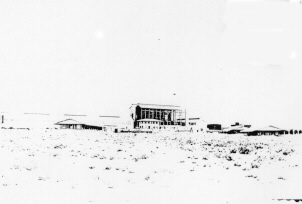Trona on the Web: The Trona Chemical Plant
 Hershel J. Stevens at work in plant Chemical company in Trona sold to IMC Global reports Karen Botham for The Bakersfield Californian Online in December 1997. IMC Global also issued a press release about the purchase in December 1997. On March 18, 2004, all operations of IMC Chemicals were sold to Sun Capital Investments and the operations in Searles Valley was renamed "Searles Valley Minerals, Inc." The following is from a brochure published by Kerr-McGee Chemical Corporation in 1989. It describes the history of the Trona Chemical plant from the beginning up until about the time it was sold to North American Chemical Corporation Lured by the Gold Rush of ’49, John W. Searles and his brother Dennis sailed from New York to California in search of precious metals. Like most prospectors, they found plenty of hardship and very little gold. Unlike most other prospectors, they found treasure of another kind. While searching for gold near the Panamint Mountains in 1862, John Searles came across a crusty dry lakebed. Noticing crystals shimmering in the sunlight, he scooped up a handful and tucked them in his oar sack, unaware that he had discovered the worlds richest deposits of chemicals. Ten years passed. Then in Nevada, Searles saw Francis "Borax" Smith recovering borax from similar crystals. Suddenly recognizing the value of the dry lake he had found in California Searles backtracked. His find was worth more than the gold that had eluded him. Searles and his associates staked claim to 640 acres and formed the San Bernardino Borax Mining Company. In 1874, its first year of operation the company produced 1 million pounds of borax worth an estimated $200,000. In the late 1870s two other operations attempted to produces borax from the lake. About the same time, borax prices fell from 30 cents pound to 10 cents pound and the newcomers closed their operations. They were the first of many to fail. Searles sold his San Bernardino Borax Mining Company in 1895 to "Borax" Smith’s Pacific Coast Borax Company, which sought to corner the borax market. The new owners shut down the plant. In the early 1900s dozens of promoters and miners tried unsuccessfully to recover soda ash from the lake’s surface. The California Trona Company borrowed nearly $2 million to build two experimental plants to recover soda ash, potash, borax and sodium sulfate from the lake. Deep in debt, placed in receivership before the facilities were completed. Serving as receiver for the failed business, S. W. Austin began building roads onto the lake and drilling exploratory wells. The Valley’s earliest operators had quite literally, scratched only the surface of the lake’s mineral wealth. Early operators recovered borax by scraping crystals from the lake’s surface crust. Austin discovered a mineral-rich layer of salts about 100 feet beneath the surface. Operators have concentrated on recovering that brine ever since. In 1913, the newly formed American Trona Company acquired the California Trona Company’s assets. Flush with money from the British firm of Consolidated Gold Fields, American Trona finished building the 31 mile Trona Railway, established the company town of Trona and completed the experimental processing plants. The new process was a bust. Two years and $1 million dollars later, American Trona developed a successful evaporation process and potash production began. The company produced 250 tons of potash from the lake in 1915.
A German embargo of potash fertilizer during World War I sharply raised potash prices, creating a rush of activity at Searles Lake – the only American source of potash at the time. The Pacific Coast Borax Company and the Solvay Process Company hastily joined forces and opened the Borosolvay plant, with Pacific Coast selling the borax and Solvay selling the potash. Potash production at Searles Lake jumped to 36,000 tons in 1916. Borosolvay closed it’s doors in 1921 when potash prices plunged American Trona, on the other hand, established research and development departments in Trona and improved its recovery process. The ‘20s ushered in a period of relative stability at Searles Lake. A new group of investors formed the American Potash & Chemical Corporation in 1926 and purchased the American Trona Company, which had finally become profitable. The investors enlarged and expanded the Trona plant several times during the next 20 years and added facilities to produce a wider range of chemicals. "Borax Smith, who had once controlled the Pacific Coast Borax Company, returned to Searles Lake in 1930 and formed the West End Chemical Company. He built a townsite at Westend and a wood-stave pipeline to bring brine to his plant. Skeletal remains of the pipeline can still be found on the lake near Westend. By 1925, Searles Lake had been under development for 52 years, Investors had sunk millions of dollars into the lake, and hundreds of prospectors had staked claims. Testifying to the toil and crumbled dreams, only two companies remained -- American Potash & Chemical Corporation and the West End Chemical Company. West End merged with Stauffer Chemical Company in 1956. Kerr-McGee acquired American Potash & Chemical Corporation in 1967 and began a multimillion-dollar study to explore the lake, develop new processes and examine market opportunities. Seven years later, Kerr-McGee acquired the Westend facility from Stauffer. Kerr-McGee completed its $175 million Argus soda ash plant in 1978. North American Chemical Corporation purchased the chemical plant around 1990 and was leasing at Searles Lake from the Bureau of Land Management up until they sold the Plant in December 1997 to IMC Global. Last Update: 02/23/2014 |
